Ion thrusters, also known as Hall-effect thrusters, can indeed produce more power than expected. Now such engines are used to regulate the orbit of satellites. But according to a new study, their power can be increased for fast interplanetary flights, for example, for a crewed mission to Mars or even further, which is previously considered unlikely and even fantastic.

Modern Hall thrusters work by accelerating ionized gas particles, such as xenon, using a magnetic field. But because of their ultra-low power, they cannot be installed on large spacecraft or even spacecraft with astronauts. Therefore, ion thrusters are installed on small probes or satellites, because they are very economical, and their weak power is quite enough for maneuvering operations.
Unexpected discovery
Benjamin Yorns, an associate professor of aerospace at the University of Michigan, said he had found a way to significantly increase the thrust of the ion thruster. He and a team of engineers accelerated the Hall thruster with a xenon engine a hundred times and tried to cool it with water to avoid overheating. They found that the thruster was able to increase power from 9 kW to 37.5 kW, while its efficiency remained at 49%.
The team continued on. In the next experiment, they used the lighter noble krypton gas as fuel. With it, they were able to achieve a power of 45 kW with an even greater efficiency of 51%.
“This is an incredible result, because it was believed that krypton works much worse than xenon on Hall thrusters. But our experiments proved something completely different. We have found that we can really improve the performance of krypton compared to xenon by increasing the current density,” said Lian Su, an aerospace engineer from the University of Michigan.
Their findings show that in the future it is possible to use small and powerful ion thrusters for manned spacecraft. According to Yorns, the crews may reach Mars or even the vicinity of the Solar System using a series of thrusters producing a total thrust of about a megawatt. But one obstacle remains to be solved: how to cool such engines in space, because it is much more difficult than on Earth.
Earlier we reported on how a nuclear rocket from NASA and DARPA would take off into space in 2027.
Follow us on Twitter to get the most interesting space news in time
https://twitter.com/ust_magazine

